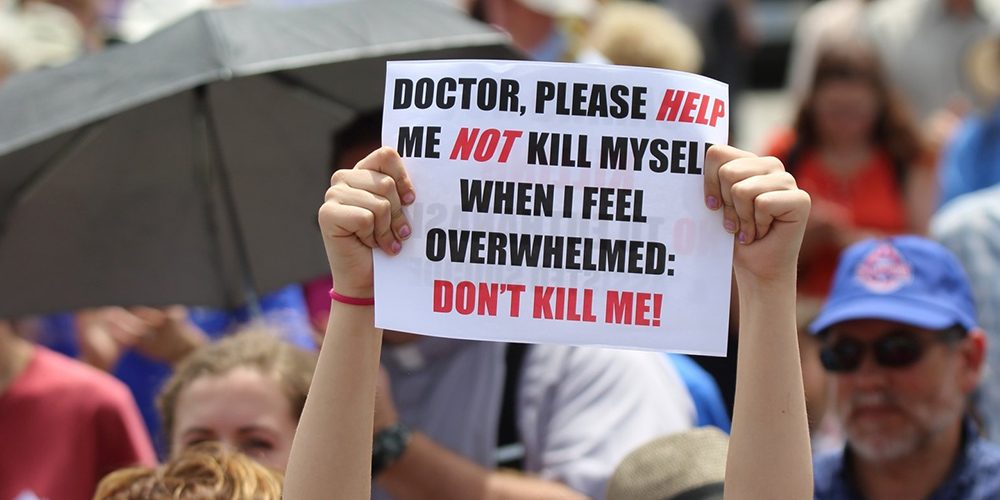Canada’s Orwellian Euthanasia Regime
In 2016, Canada legalized euthanasia nationwide. To date, according to the government’s own records, more than 30,000 people have been killed by physicians. In some parts of the country, euthanasia is accounting for up to 5% of all deaths. Throughout the past several years, euphemisms for euthanasia have changed from physician-assisted suicide to physician-assisted dying to medically-assisted death to “medical assistance in dying” to MAiD (with a lower-case ‘i’) to, ultimately, the attempted erasure of the fact that it is even an acronym. Euthanasia in Canada is now ubiquitously referred to as—MAID.
Despite having had among the harshest lockdown policies and highest vaccination rates, it is possible that by this time next year the number of deaths from euthanasia will surpass the total number of deaths from COVID in this country.
However, it may soon be hard to keep track given the deliberate obfuscation and falsification of euthanasia records.
Ontario is Canada’s most populous province. Its College of Surgeons and Physicians provides the following definition for Medical Assistance in Dying (MAID):
Under the federal legislation, MAID refers to circumstances where a physician or nurse practitioner, at a patient’s request: (a) administers medications that cause a patient’s death; or (b) prescribes or provides medications for a patient to self-administer to cause their own death, in accordance with the legal requirements. (emphasis mine)
Having clearly acknowledged the procedure causes death, it is curious that the same governing body wants to omit any reference to it as a cause of death for the purpose of completing death certificates.
This month, the College is soliciting feedback on a draft policy, which includes this section concerning death certificates:
Physicians who provide MAID must complete the medical certificate of death.
When completing the medical certificate of death, physicians: must list the illness, disease, or disability leading to the request for MAID as the cause of death; and must not make any reference to MAID or the medications administered on the certificate. (emphasis mine)
Here we have the deliberate directive by a governing professional body to falsify medical records. A doctor’s administration of midazolam, propofol, and rocuronium is undeniably the cause of his or her patient’s premature death. But soon, we may no longer know the number of Canadians being euthanized because of the host of other “causes” being listed on death certificates to mask the widespread death-by-doctor.
This will become more bizarre when, beginning on March 17, 2023, mental illnesses such as depression, which are not normally fatal in and of themselves, begin being listed as the underlying cause of death on certificates.
Euthanasia was legalized in 2016 for informed and consenting adult Canadians deemed to have a “grievous and irremediable condition.” Initially, there were safeguards that required the request be made in writing before two independent witnesses, the capacity to withdraw the request at any time, and a mandatory reflection period. In 2021, these safeguards were eroded to require only one independent witness, allow the possible waiving of the requirement for final consent, and remove the 10-day reflection period. At the same time, euthanasia eligibility was expanded to include a new track for “persons whose natural death is not reasonably foreseeable.” This includes Canadians living with a disability and, beginning this March, those whose sole medical condition is a mental illness will become eligible, too.
However, despite euthanasia lobbyists insisting that “medical assistance in dying is a legal, federally regulated end-of-life choice, driven by hope and autonomy,” the mandating of professional cover-up betrays the pangs of conscience that still admit there is something fundamentally wrong with it.
We do no one any service by listing false causes of death in place of the person’s own stated rationale. We need to know why we are seeing a 32.4% increase in euthanasia deaths from one year to the next.
Many Canadians think that what makes euthanasia acceptable is that the patient him- or herself has requested it. But then why not list the cause of death as “the patient’s will”? Perhaps it is because deep down physicians know and could agree with the statement by philosopher Emmanuel Levinas who said, “I have increasingly more responsibility than the Other, I am responsible even for his responsibility.”
Physicians first and foremost are responsible for ensuring their patient’s health and are in a position of obvious authority. This is why it is extremely dangerous for physicians to be mandated, as the College is also suggesting, to raise euthanasia as a possible “treatment” option with any patient who is eligible. Particularly when coming from a doctor, the presentation of this option is tantamount to a recommendation.
Some physicians cannot imagine any circumstances in which counselling an assisted death would be appropriate on the commonsensical basis that killing cannot be conducive to wellbeing since it stops a person from being altogether. I recently heard a Canadian doctor say, “If you can show me how MAID promotes the health of my patients, then I will do it—cheerfully. Just like I will do anything else that I think promotes the health of my patients. But until someone can show me that, I won’t do it.” Physicians committed to not causing harm and to helping a person live well until they die will not be complicit in deliberately ending a person’s life prematurely.
We also know that the legalization of euthanasia is drastically undermining suicide prevention efforts (this is apparent because practically every euthanasia death is an assisted suicide). The question becomes: Who gets suicide prevention and who gets suicide facilitation? If death is executed on the basis of anybody’s momentary consent, then whither the legitimacy of ever attempting to dissuade a person in distress?
Furthermore, we know from first-hand testimony that Canadians are being severely tempted to ask for euthanasia on the basis of homelessness, poverty, lack of homecare, inadequate housing, depression, and diabetes and blindness.
Shame on us if, in our advanced and prosperous country to which much of the world would love to come, our inability to support one another adequately in our communities is what is really leading to requests for euthanasia. Do we dare to look around at the loneliness and abandonment driving people to deaths of quiet desperation and say that maybe the cause of death is actually us? We are not sufficiently present. We do not yet know how to patiently abide difficult situations. It’s been a long time since we’ve held someone’s hand tenderly, patiently, even for a long while. Maybe we’ve never done it.
Being truthful is the first step to restoring moral sobriety. According to the government’s own survey on the nature of suffering among those requesting euthanasia, 86.3% cited “the loss of ability to engage in meaningful activities.” The cause of these deaths is, by people’s own admission, existential rather than physiological. This is important and deserving of our attention. And we do no one any service by listing false causes of death in place of the person’s own stated rationale. We need to know why we are seeing a 32.4% increase in euthanasia deaths from one year to the next.
The falsification of medical records is sinister and reminds me of an exhibit I saw last spring at the former concentration camp, Mauthausen. This was a site at which the Nazis conducted some of their so-called medical experiments of which they kept meticulous records that are now on public display.
Beneath the glass case, there is a book with elegantly legible handwriting. It is a death register of the SS chief physician of the camp. The accompanying museum caption says:
The SS has false causes of death registered. The prisoner Ernst Martin, assigned as a clerk, puts secret marks in the death register against cases where he learns that the prisoners were killed deliberately. By putting a dot after the place of birth, he identifies the victims of lethal injections.
If, years from now, someone finds a discreet dot on each of the medical certificates of Canadians who were in fact euthanized, we’ll know where they got the idea and be glad they did so we can know the truth.


